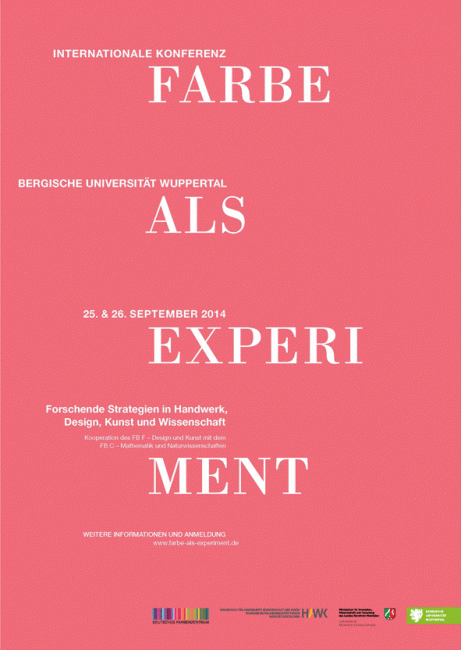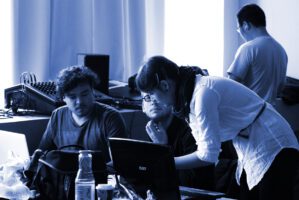Research strategies in crafts, design, art and science
Over 50 interdisciplinary contributions in the form of lectures, workshops, experiments and exhibition contributions formed a unique forum for the interdisciplinary exchange of knowledge and plenty of space for active sensory cognitive processes. The “German Color Center – Central Institute for Color in Science and Design”, represented by the head of the board Prof. Dr. Axel Buether (Didactics of Visual Communication) and Prof. Dr. Johannes Grebe-Ellis (Didactics of Physics), has thus successfully arrived at its new location, the University of Wuppertal.
The assembled fields of knowledge and application of color presented current research and development issues in their disciplines in a university sense of continuing education, which is characterized by participation, interdisciplinarity and knowledge transfer.
Color as an experiment
Experimentation stands for curiosity, dialogue and participation, for interaction and the materialization of visions, hypotheses and theories. Experimenting with the medium of color promotes and shapes the cognitive process in crafts, design, architecture, art and science.
While the testing of materials, aesthetics and manufacturing practices in crafts and arts and crafts is primarily aimed at the development of new products, the design object lives decidedly from its experimental process. In architecture and interior design, experimentation with color serves to explore the open spaces for the aesthetically shaped urban, landscape and private space, which, in the focus of historical observation, can be addressed as a mirror of the zeitgeist of changing societies. In art and media, color experimentation opens up and offers new possibilities for perception and communication about affective experiences, not least by creatively crossing boundaries and questioning conventions.
Color science and research use experiments and tests as a basis for analyzing and researching current natural and social science and technological issues and generating possible answers and application solutions.
Through multiple changes of perspective and a variety of suggestions for lateral thinking, the conference aims to open up an innovative discourse in this form, which is intended to stimulate new interdisciplinary research, cooperative practice and creative impulses in all areas of thought, design and application of color.
Further training
4 keynotes by internationally renowned experts, 24 specialist lectures from various scientific, technological and design disciplines and 12 practical application workshops created a unique range of further training courses on all fields of knowledge and practice in color. The physics didactics laboratory offered an open experimentation room with a continuous presentation of experiments, color-light installations and new teaching aids. The Color Design Forum presented 7 young designers and design agencies as well as innovative materials to touch and try out. The conference’s accompanying program featured an extensive themed exhibition that allowed all participants to experience current practical approaches to color in crafts, painting, sculpture, graphics, photography, film, interaction and space.
Interdisciplinarity
The experiment with color as a phenomenon, medium, material and atmosphere combines theory and practice in crafts, design, architecture, art and science. This creates a unique forum for interdisciplinary exchange, which enables a deeper understanding and provides all participants with targeted and randomly experienced suggestions for later thought and creative processes. The vividly presented research project “Color as an actor and memory” shows why interdisciplinary questions about color are a current focus of research funding.
More information and documentation:
Homepage Color as an experiment
Conference management
Prof. Dr. Axel Buether
Prof. Dr. Johannes Grebe-Ellis
Timo Rieke, Administrative Prof.
AOR Ulrich Seiss
Download conference program Color as an experiment
Feedback:
“Thank you very much for the invitation to this experimental and, for me, very exciting conference.” – Prof. Dr. Klaudia Witte, University of Siegen, Ecology and Behavioral Biology
“A big thank you for the perfect organization of the all-round successful conference, which will certainly remain in the best memories of all participants – it really was a great experience!” – Dr. André Karliczek, Friedrich Schiller University Jena, History of Medicine, Science and Technology
“I can only say that we thoroughly enjoyed the event. There was a great atmosphere.” – Caroline Venn and Ulrich Welter, Manufactory for unique wall art Berlin
“I really liked it in Wuppertal! – Prof. Dr. Rolf Sachsse, Hochschule der Bildenden Künste Saar, Design History and Theory
“I felt very comfortable with you, but also very sorry that I could not attend the conference for longer. There were a number of presentations that would have interested me.” – Prof. Dr. Peter Weibel, ZKM Center for Art and Media Karlsruhe
“I would like to express my high praise for the choice of speakers and topics, but also for the preparation and organization of the conference. The quality of the conference is hard to beat.” – Michael Bablick, expert, author of textbooks and reference books for the painting and decorating trade, Munich
“I had a lot of fun with you. THANK YOU again for the invitation! You really noticed how much work and love went into this conference. The topics and presentations were very well chosen and the range was super interesting and comprehensive.” – Mario Schwary, Interbrand, Berlin
“It was great to be part of such illustrious company and a special conference. All in all, I think it was a very successful event. Extremely enriching on so many levels.” – Claudia Sarkany, University of Wuppertal
“Overall, this conference was a great and rich experience for me.” – Natacha Le Duff, Museum of Colors, Berlin
“Many thanks to you too. It was a great pleasure and experience for us to give a lecture in this setting. It’s also great to see how the color design sector has developed in recent years, respect for that!” – Tomislav Topic and Thomas Granseuer, Quintessenz, Berlin, Hanover
“The combination of lectures, workshops and exhibition is a wonderful concept. In our view, the workshops have great potential as a combination of practical/experimental part and theoretical input. The workshop character with a limited number of people makes a real debate/discussion/exchange the easiest possible and also promotes this.” – Marcus Pericin and Florian Bachmann, Zurich
“I also enjoyed the event and found it enriching and look forward to seeing you again.” – Ingo Nussbaumer, Vienna
“Many thanks again for the wonderful conference.” – Anke Zürn, Basel
“Congratulations and thanks to you and the Wuppertal staff, especially the students, for a successful conference.” – Dr. Andreas Schwarz, University of Duisburg-Essen, Art Education
“Many thanks to your team! It was great.” – PD Eckhard Bendin, specialist book author, visual artist, color designer, Dresden
“Many thanks and congratulations for a very successful conference!” – Prof. Andreas Kalweit, University of Wuppertal, Manufacturing & Material Science
“The conference was fun, as it brought together a lot of exciting people.” – Dr. Tim Otto Roth, artist and media scientist, Cologne
“Many thanks for the excellently organized conference. I would also like to thank your staff and students for always being so friendly and helpful. I would particularly like to congratulate you on your choice of speakers – a very successful mix.” – Dr. Georg Kremer, Kremer Pigmente Aichstetten
“Thank you, very much. Yes, a collaboration across the ocean…” – Prof. Esther Hagenlocher, Department of Architecture, School of Architecture and Allied Arts, University of Oregon, USA



